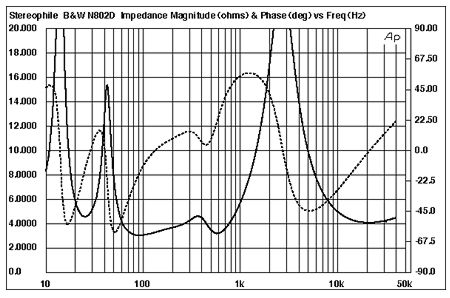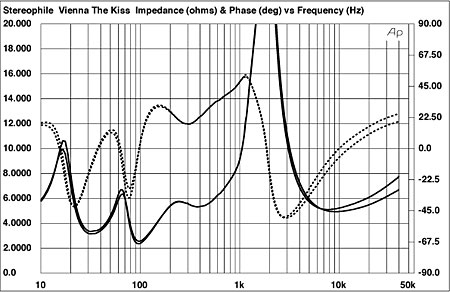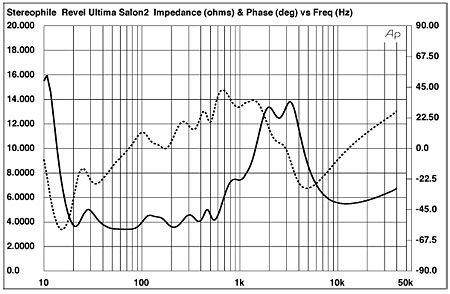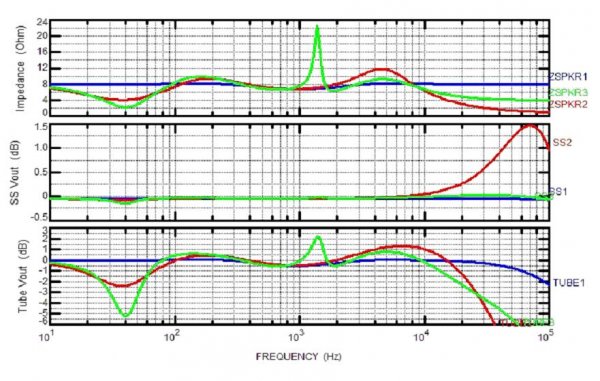Showing the impact of speaker loading on amplifiers is not too hard but is tedious (at least it was for me!) I set up two amps and two speakers, then plotted the speaker impedance and frequency response at the amplifier terminals. The speakers were 8-ohm nominal, 3-way, with crossovers at 300 Hz and 3 kHz. The first amp is SS with 0.1 ohm output (damping factor of 80) rising to about 1 ohm (DF=12.5) at 20 kHz. This mimics the way a lot of amplifiers behave with rising output impedance with frequency. The second amp is a tube amp with 0.8-ohm output (DF=10) rising to about 4 ohms at 20 kHz (DF=2; this is about as bad as I have measured in the primordial past).
The top plot shows the impedance, the next the amplifier outputs, and in the bottom plot I repeated the first amplifier’s response and then showed differences from each other amplitude to that first (SS) amp.
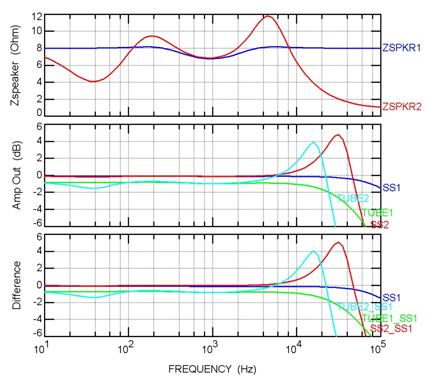
Speaker 1 shows pretty benign magnitude, with a slight dip where the midrange driver comes into play. The dip is because I used very simple first-order crossovers so there is some interaction among drivers. For the second speaker, I started with the network from the first, then added a roll-off at the high end to simulate a ribbon-type tweeter and a resonance dip to 4 ohms in the bass. This led to some peaks as well, though nothing terribly extreme.
Looking at the plots in the middle we can see how the amplifier’s impedances influence the response. A perfect amp would show a straight line. The SS amp into Speaker 1 (SS1, blue) shows very flat response with a bit of HF roll-off as expected. The tube amp into the first speaker (TUBE1, green) has a little less amplitude due to the higher impedance (this is insignificant since you’d just turn up the volume a little) and the HF roll-off kicks in sooner (again, expected for a tube amp). The plots into the second speaker are more interesting, with both amps showing some peaking at HF. This is because the rising output impedance is interacting with the capacitive load and causing a peak. Yes, this can happen in real life; it is one reason some amps are not stable with highly-capacitive loads. The peak is larger and at higher frequency with the SS amp (SS2, red) compared to the tube amp (TUBE2, light blue). This is because of the tube amps higher output impedance and faster HF roll-off. Note the tube amp into speaker 2 also has a LF dip, demonstrating the trouble it has driving low-impedance loads even at LF.
The final plot shows the SS amp into speaker 1, SS1 (blue), and the difference between that response and the other outputs. This is what we might hear when comparing amplifiers. Into the second speaker, the SS amp (red) is almost 3 dB higher at 20 kHz, peaking at ~5 dB at ~25 kHz, then rolling off. There is only about 1 dB difference at 10 kHz, rapidly decreasing to zero (a perfect match) below that. The tube amp into speaker 1 rolls off a little sooner, but is only about 1 dB down at 20 kHz, a difference we are unlikely to hear. Into the second speaker, the tube amp’s HF peak is about 4 dB at 15 kHz, dropping on either side. There is also that dip of ~1 dB at 30 Hz.
Can you hear this? I don’t know, but in a careful side-by-side test you might. Real amplifier and speaker impedances are more complicated and so might fare better or worse in a test. However, at least it shows that bad things can happen to good amps when presented with the real world of speakers.
HTH - Don
The top plot shows the impedance, the next the amplifier outputs, and in the bottom plot I repeated the first amplifier’s response and then showed differences from each other amplitude to that first (SS) amp.

Speaker 1 shows pretty benign magnitude, with a slight dip where the midrange driver comes into play. The dip is because I used very simple first-order crossovers so there is some interaction among drivers. For the second speaker, I started with the network from the first, then added a roll-off at the high end to simulate a ribbon-type tweeter and a resonance dip to 4 ohms in the bass. This led to some peaks as well, though nothing terribly extreme.
Looking at the plots in the middle we can see how the amplifier’s impedances influence the response. A perfect amp would show a straight line. The SS amp into Speaker 1 (SS1, blue) shows very flat response with a bit of HF roll-off as expected. The tube amp into the first speaker (TUBE1, green) has a little less amplitude due to the higher impedance (this is insignificant since you’d just turn up the volume a little) and the HF roll-off kicks in sooner (again, expected for a tube amp). The plots into the second speaker are more interesting, with both amps showing some peaking at HF. This is because the rising output impedance is interacting with the capacitive load and causing a peak. Yes, this can happen in real life; it is one reason some amps are not stable with highly-capacitive loads. The peak is larger and at higher frequency with the SS amp (SS2, red) compared to the tube amp (TUBE2, light blue). This is because of the tube amps higher output impedance and faster HF roll-off. Note the tube amp into speaker 2 also has a LF dip, demonstrating the trouble it has driving low-impedance loads even at LF.
The final plot shows the SS amp into speaker 1, SS1 (blue), and the difference between that response and the other outputs. This is what we might hear when comparing amplifiers. Into the second speaker, the SS amp (red) is almost 3 dB higher at 20 kHz, peaking at ~5 dB at ~25 kHz, then rolling off. There is only about 1 dB difference at 10 kHz, rapidly decreasing to zero (a perfect match) below that. The tube amp into speaker 1 rolls off a little sooner, but is only about 1 dB down at 20 kHz, a difference we are unlikely to hear. Into the second speaker, the tube amp’s HF peak is about 4 dB at 15 kHz, dropping on either side. There is also that dip of ~1 dB at 30 Hz.
Can you hear this? I don’t know, but in a careful side-by-side test you might. Real amplifier and speaker impedances are more complicated and so might fare better or worse in a test. However, at least it shows that bad things can happen to good amps when presented with the real world of speakers.
HTH - Don



